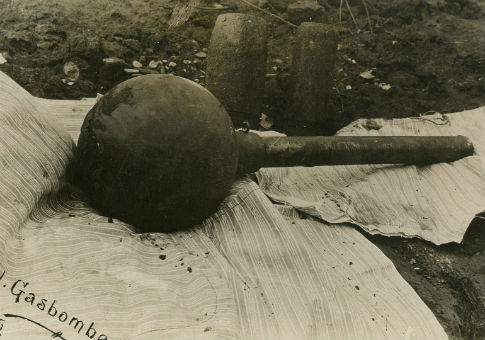Syria’s government is now regularly using poisonous chlorine gas, a weapon that was first deployed in war a century ago that causes it victims to feel as if they were drowning on dry land, against its people.
The regime of President Bashar al-Assad is accused of launching dozens of attacks with chlorine bombs in the past two years. While Assad agreed to relinquish his chemical weapons stockpile as part of a deal brokered with the United States and Russia in 2013, chlorine was not specifically listed as one of the banned weapons.
Speaking to the press at Camp David on Thursday, President Obama responded to reports of Syria’s use chlorine, saying, "Chlorine, itself, historically has not been listed as a chemical weapon, but when it is used in this fashion, can be considered a prohibited use of that particular chemical."
Mark Bishop, a professor of nonproliferation and terrorism studies at the Monterey Institute of International Studies, said in an email that chlorine "is both the first chemical weapon in the modern era and the one that has been more recently used." As a common chemical with several uses in civilian life, it tends to elicit less scrutiny than other chemical weapons such as nerve agents, he said.
Nonetheless, chlorine gas in concentrated doses is just as devastating to its victims. Bishop described the effects as "dry land drowning."
"When inhaled, it reacts with water on the eyes and in the lungs to form hydrochloric acid and hypochlorous acid," he said. "These acids are damaging and very irritating to the tissues. On the eyes, it can cause extreme irritation that can lead to at least temporary blindness."
"In the lungs, the body rushes water to the site of irritation to minimize damage," he continued. "This leads to excess fluid in the lungs and trouble breathing, and in the extreme, it leads to ‘dry land drowning.’"
Assad allegedly killed more than 1,400 people in August 2013 when he ordered a sarin gas attack near Damascus. As part of the U.S.-Russian agreement, Syria joined the Chemical Weapons Convention (CWC) and agreed to hand over its chemical weapons for destruction. Chlorine, which has many civilian uses such as water purification, is not included in the CWC.
However, the use of any chemical as a weapon violates the CWC.
President Barack Obama initially threatened to launch airstrikes against the Assad regime in 2013 after the sarin gas attack near Damascus, but he reversed course after the chemical disarmament deal with Russia was reached. The United States is "working with the international community" to investigate the allegations of chlorine attacks, he said on Thursday.
"And so we're working with the international community to investigate that and, in fact, if we have the kinds of confirmation that we need, we will, once again, work with the international community and the organization charged with monitoring compliance by the Syrian government, and we will reach out to patrons of Assad, like Russia, to put a stop to it," the president said.
Chlorine gas first appeared on the battlefield in April 1915 when the German army used it against French troops. The British then retaliated by weaponizing chlorine themselves. Saddam Hussein later used other chemical weapons against Iran and the Kurdish people of northern Iraq in the 1980s—including the blistering agent mustard gas and nerve agents such as sarin and VX—in attacks that killed thousands. Now that Assad is reported to have turned over many of his other chemical weapons, chlorine has again resurfaced as a brutal weapon of war.
Chlorine attacks this year are reported to have killed dozens of civilians in Syria, including children. Some residents now say they fear chlorine more more than the shrapnel-filled barrel bombs that Syrian forces are suspected of dropping on civilian populations.
Assad likely views the use of chlorine as a chemical weapons loophole. In addition to not being listed on the CWC, its use is also difficult to document on the battlefield.
"It dissipates quickly, so verification of its use would need to come from the symptoms of those people exposed and firsthand accounts of the attack," Bishop said.
Inspectors from the Organization for the Prohibition of Chemical Weapons (OPCW) are also reported to have discovered traces of banned chemical weapons, including sarin, in at least three Syrian military sites. The findings raise questions about whether Assad declared his full chemical weapons stockpile to U.S. and United Nations officials.
Bishop said the allegations of chlorine attacks make it more likely that the Assad regime has retained some traces of nerve agents.
"If the Syrian government has indeed been using chlorine as a weapon, it shows that they are not committed to the guidelines of the CWC, making the possibility of them holding back some nerve agent precursors more believable," he said.
The international community has yet to take any concrete actions in response to the chlorine attacks in Syria. While the OPCW determined last year that chlorine gas was used "systematically and repeatedly" in villages in northern Syria, it was not granted the authority to assign blame. Russia, a staunch ally of Syria’s and one of its main weapons suppliers, has wielded its veto on the U.N. Security Council to block further pressure on the Assad regime.
The Syrian government continues to deny that it has used chemical weapons in the country’s civil war, but experts disagree.
"Both Human Rights Watch and the Organization for the Prohibition of Chemical Weapons have presented strong evidence that chlorine is being delivered from helicopters, and the only combatant in this conflict that has helicopters is the Syrian government," said Amy Smithson, a chemical weapons expert, in an interview with NPR last month. "So I have absolutely no doubt who's behind this."
